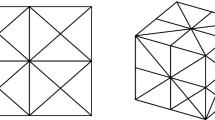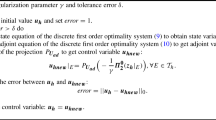Abstract
We show how the software Femlab can be used to solve PDE-constrained optimal control problems. We give a general formulation for such kind of problems and derive the adjoint equation and optimality system. Then these preliminaries are specified for the stationary Navier–Stokes equations with distributed and boundary control. The main steps to define and solve a PDE with Femlab are described. We describe how the adjoint system can be implemented, and how the optimality system can be used by Femlab’s built-in functions. Special crucial topics concerning efficiency are discussed. Examples with distributed and boundary control for different type of cost functionals in 2 and 3 space dimensions are presented.
Similar content being viewed by others
References
Abergel, F., Casas, E.: Some optimal control problems associated to the stationary Navier–Stokes equation. In: Diaz, J.-I., et al. (ed.) Mathematics, Climate, and Environment, Res. Notes Appl. Math., vol. 27, pp. 213–220. Masson, Paris (1993)
Burkard, J., Peterson, J.: Control of steady incompressible 2D channel flow. In: Gunzburger, M.D. (ed.) IMA Vol. Appl. Math., vol. 68, pp. 111–126. Springer, Berlin Heidelberg New York (1995)
Comsol Inc. http://www.femlab.com
de los Reyes, J.C., Kunisch, K.: A semi-smooth Newton method for control constrained boundary optimal control of the Navier–Stokes equations. Nonlinear Anal. 62, 1289–1316 (2005)
Desai, M., Ito, K.: Optimal controls of Navier–Stokes equations. SIAM J. Control Optim. 32(5), 1428–1446 (1994)
Girault, V., Raviart, P.-A.: Finite Element Methods for Navier–Stokes Equations. Springer Series in Computational Mathematics 5, New York (1986)
Glowinski, R.: Finite element methods for incompressible viscous flow. In: Ciarlet, P.G., Lions, J.L. (eds.) Handbook of Numerical Analysis, vol. IX. North-Holland, Amsterdam (2003)
Gunzburger, M.D., Hou, L., Svobodny, T.P.: Analysis and finite element approximation of optimal control problems for the stationary Navier–Stokes equations with distributed and Neumann controls. Math. Comput. 57(195), 123–151 (1991)
Heinkenschloss, M.: Formulation and analysis of a sequential quadratic programming method for the optimal Dirichlet boundary control of Navier–Stokes flow. In: Hager, W.H., Pardalos, P. (eds.) Optimal Control: Theory, Algorithms, and Applications, pp. 178–203. Kluwer, Dordrecht (1998)
Hinze, M., Kunisch, K.: Second order methods for boundary control of the instationary Navier–Stokes system. Z. Angew. Math. Mech. 84(3), 171–187 (2004)
Hou, L.S., Ravindran, S.S.: Numerical approximation of optimal flow control problems by a penalty method: Error estimates and numerical results. SIAM J. Sci. Comput. 20, 1753–1777 (1999)
Lions, J.L.: Optimal Control of Systems Governed by Partial Differential Equations. Springer, Berlin Heidelberg New York (1971)
Màlek, J., Roubićek, T.: Optimization of steady state flows for incompressible viscous fluids. In: Sequiera, A., Beirao da Vega, H., Videman, J.H. (eds.) Nonlinear Applied Analysis, pp. 355–372. Plenum, New York (1999)
The Mathworks, Inc. http://www.matlab.com
Nocedal, J., Wright, S.J.: Numerical Optimization. Springer, Berlin Heidelberg New York (2000)
Roubićek, T., Tröltzsch, F.: Lipschitz stability of optimal controls for the steady state Navier–Stokes equations. Control and Cybernetics 32, 683–705 (2003)
Slawig, T.: A formula for the derivative with respect to domain variations in Navier–Stokes flow based on an embedding domain method. SIAM J. Control Optim. 42(2), 495–512 (2003)
Temam, R.: Navier–Stokes Equations. North-Holland, Amsterdam (1979)
Author information
Authors and Affiliations
Corresponding author
Additional information
Communicated by Claude Brezinski.
Rights and permissions
About this article
Cite this article
Slawig, T. PDE-constrained control using Femlab – Control of the Navier–Stokes equations. Numer Algor 42, 107–126 (2006). https://doi.org/10.1007/s11075-006-9026-6
Received:
Revised:
Accepted:
Published:
Issue Date:
DOI: https://doi.org/10.1007/s11075-006-9026-6




